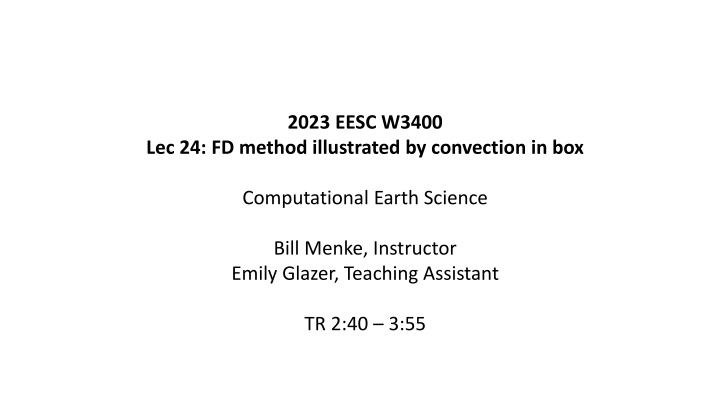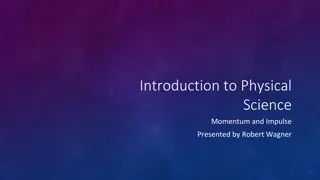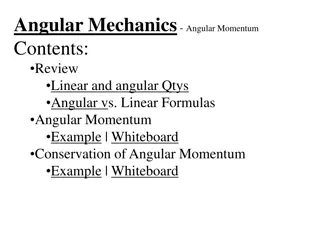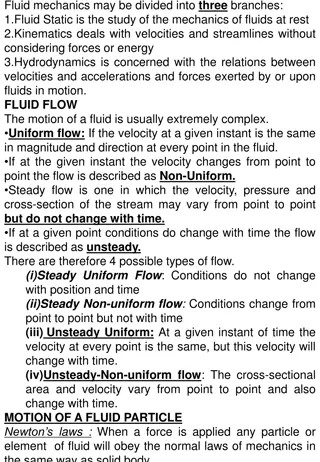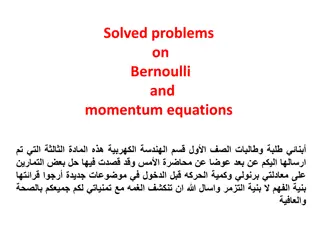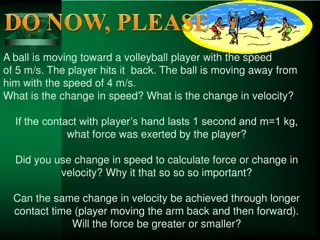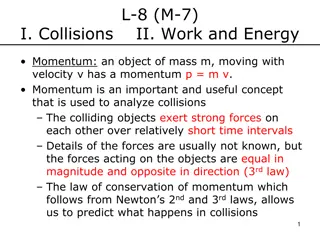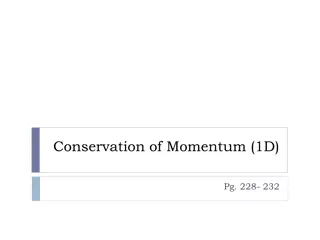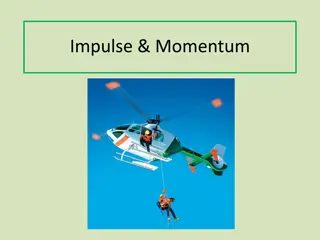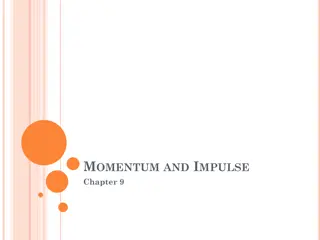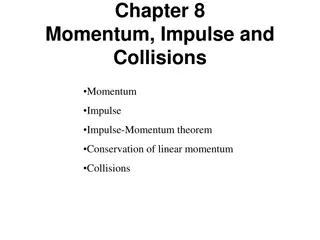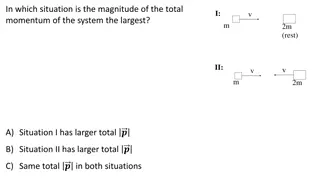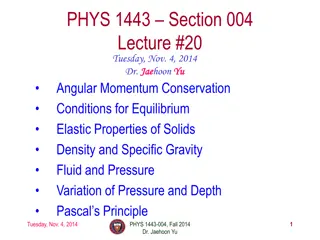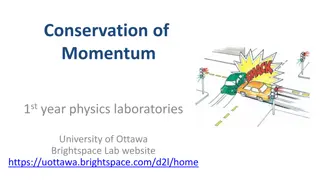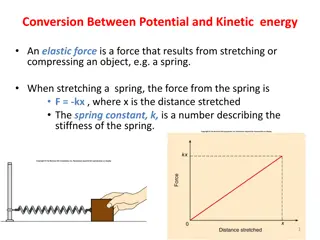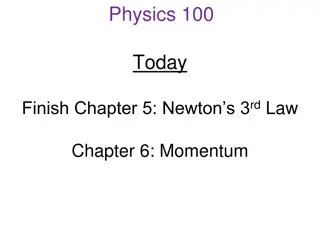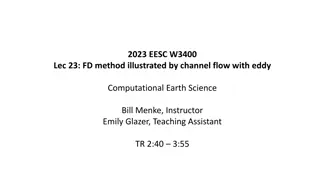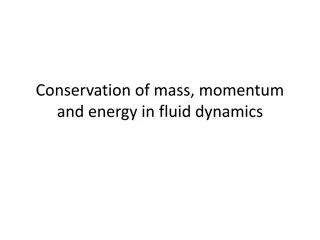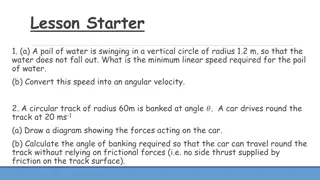Introduction to Conservation of Momentum in Fluid Dynamics
Explore the fundamentals of the Navier-Stokes Equation, incompressibility condition, heat flow equation, dynamics of convection, and the Boussinesq Approximation. Learn about the setup for convection in a box and the finite difference simulation of convection, along with terms like vector notation and the dynamics of momentum.
Download Presentation

Please find below an Image/Link to download the presentation.
The content on the website is provided AS IS for your information and personal use only. It may not be sold, licensed, or shared on other websites without obtaining consent from the author.If you encounter any issues during the download, it is possible that the publisher has removed the file from their server.
You are allowed to download the files provided on this website for personal or commercial use, subject to the condition that they are used lawfully. All files are the property of their respective owners.
The content on the website is provided AS IS for your information and personal use only. It may not be sold, licensed, or shared on other websites without obtaining consent from the author.
E N D
Presentation Transcript
2023 EESC W3400 Lec 24: FD method illustrated by convection in box Computational Earth Science Bill Menke, Instructor Emily Glazer, Teaching Assistant TR 2:40 3:55
Today 1. review the Navier Stokes Equation 2. derive the incompressibility condition 3. review the heat flow equation 4. dynamics of convection 5. Boussinesq Approximation 6. Setup for convection is a box 7. Things we know about convection is a box 8. Finite Difference simulation of convection
Part 1 review of the Navier Stokes Equation (equation for conservation of momentum in a moving fluid)
Conservation of momentum in a moving fluid increase in momentum with time = flow of momentum into box + external force + pressure force + viscous force
terms like ???? ?? vector notation ??? ?? increase in momentum with time = flow of momentum into box + external force + pressure force + viscous force
terms like vector notation ??? ?? increase in momentum with time = ???? ? ? ? ???? flow of momentum into box + external force + pressure force + viscous force
terms like vector notation ??? ?? increase in momentum with time = ? ? ? flow of momentum into box ?? + external force ? + pressure force + viscous force
terms like vector notation ??? ?? increase in momentum with time = ? ? ? flow of momentum into box + external force ? ?? ?? ? + pressure force + viscous force
terms like vector notation ??? ?? increase in momentum with time = ? ? ? flow of momentum into box + external force ? ? + pressure force ??2?? ??2 ? 2? + viscous force
increase in momentum with time flow of momentum into box external force pressure force viscous force - + = + ??? ?? ? 2? + ? ? ? ? ? =
increase in momentum with time flow of momentum into box external force pressure force viscous force - + = + ?? ?? ? 2? ? ? ? + ? ? = ? ? =? ? kinematic viscosity
Part 2 incompressibility condition no compression or extension of fluid, so what goes in some faces of a box must go out the others
net horizontal loss ??? ??? + ? ? ? ??? + ? ??? ? ??? + ? ??? x ??? ?x x ? x ?
??? + ? net vertical loss net horizontal loss ??? ??? ??? + ? ? ? ? ? ??? ??? + ? ??? ? ??? + ? ??? z ??? ?z x ? x ? ??? ?x x ?
no net loss ? ? ? ? ??? ??? ?x x ? ??? ?z x ? = 0 +
no net loss ? ? ? ? ??? ??? ?x+??? ?z= 0
no net loss ? ? ? ? ??? divergence = zero vector notation ? = 0 ??? ?x+??? ?z= 0
Part 3 review of the Heat Conservation Equation (equation for conservation of heat energy)
conservation of heat energy increase in heat with time = flow of heat into box due to conduction + flow of heat into box due to advection + heat source
terms like vector notation ?? ?? ?? ?? ??? ??? increase in heat with time = flow of heat into box due to conduction + flow of heat into box due to advection + heat source
terms like vector notation ?? ?? ??? increase in heat with time = ??2? ??2 flow of heat into box ? 2? due to conduction + flow of heat into box due to advection + heat source
terms like vector notation ?? ?? ??? increase in heat with time = flow of heat into box ? 2? due to conduction ?? ?? + flow of heat into box due to advection ?? ? ? + heat source
terms like vector notation ?? ?? ??? increase in heat with time = flow of heat into box ? 2? due to conduction + flow of heat into box due to advection ? ? + heat source
flow of heat into box due to conduction increase in heat with time flow of heat into box due to advection - = heat source ?? ?? + ? 2? = + ???? ? ???
flow of heat into box due to conduction increase in heat with time flow of heat into box due to advection - = heat source ?? ?? + 2? = + ? ? ??? ? = ??? thermal diffusivity
Part 4 dynamics of convection
temperature change causes density change ? = ?0(1 ? ?0 10 5 per K for rock 0.1% for ? = 100 K pretty small
temperature change causes density change ? = ?0(1 ? ?0 density change causes buoyancy change ? = ? ? ?0 ?
temperature change causes density change ? = ?0(1 ? ?0 density change causes buoyancy change ? = ? ? ?0 ? ?? ?? buoyancy change causes velocity change
temperature change causes density change ? = ?0(1 ? ?0 density change causes buoyancy change ? = ? ? ?0 ? ?? ?? buoyancy change causes velocity change velocity change causes advection of heat ? ?
temperature change causes density change ? = ?0(1 ? ?0 density change causes buoyancy change ? = ? ? ?0 ? ?? ?? buoyancy change causes velocity change velocity change causes advection of heat ? ? ?? ?? advection of heat causes temperature change
now suppose that ? is being transported by fluid motion ?? ??+ ? ? =? ? ? + ? 2? ? = ? ? ?0 ? ? = ?0(1 ? ?0 ?? ??+ ? ? = ? 2? + ??? Feedback !
Part 5 Boussinesq Approximation Changing density only affects buoyancy force
density change too small to affect fluid velocity or heat flow directly ?? ??+ ?0 ? ? =? ? ?0 ? ? + ? 2? ?0 ?0 ? = ?0(1 ? ?0 ?? ??+ ? ? = 2? + ?0??
5 unknowns: ??,??,??,?,? ?? ??+ ? ? = ? ? ?0 ? ? + ? 2? 3 equations 0 5 ? = 0 1 equation equations ?? ??+ ? ? = 2? + 1 equation ?0?? so, some hope of a solution
5 unknowns: ??,??,??,?,? ?? ??+ ? ? = ? ? ?0 ? ? + ? 2? 3 equations 0 5 ? = 0 1 equation equations ?? ??+ ? ? = 2? + 1 equation ?0?? but non-linearities here
Part 6 Set up for Convection in a Box
geometry of problem ? no heat sources gravity vertically downward ?
? ? = 0 and ??? ?? = 0 and ??= 0 no flow through top or bottom ? ? = ?0 and ????? = 0 and ??= 0
? ? = 0 and ??? ?? = 0 and ??= 0 no drag force exerted on top or bottom ? ? = ?0 and ????? = 0 and ??= 0
? ? = 0 and ??? ?? = 0 and ??= 0 heated from bottom ? ? = ?0 and ????? = 0 and ??= 0
? ? = 0 and ??? ?? = 0 and ??= 0 repeating boundary conditions repeating boundary conditions ? ? = ?0 and ????? = 0 and ??= 0
Part 7 five things we know about Convection in a Box
Thing We Know #1: If you work in scaled variables of order 1 in size ? = ?/ position scaled by height of box ? = ?/ ? = ? / 2 time by rate at which heat conducts temperature as fractional deviation from the mean ? = ?0 ?0/ ?0 2 1 ?? = ?? velocity by combining position and time scaling 2 1 ?? = ?? pressure by scaled deviation from hydrostatic 2 ? = ? ?0?? ??0
If you work in scaled variables ... (order 1 in size) then the ONLY two material constant are the Rayleigh Number Prandtl Number ??=? ??= 3?0? ?0? and ? and only these two combinations of material parameters affects the pattern of convection
in primed variables (but omitting primes) 1 ?? ?? ??+ ? ? = ??? ? ? + 2? ? = 0 ?? ??+ ? ? = 2?
Thing We Know #3: For the earths mantle ?? 104 ?? 1024 so two terms can be eliminated from the Navier Stokes equations 1 ?? ?? ??+ ? ? = ??? ? ? + 2? 0 = ??? ? ? + 2?
Thing We Know #3: For the earths mantle ?? 104 ?? 1024 so two terms can be eliminated from the Navier Stokes equations 1 ?? ?? ??+ ? ? = ??? ? ? + 2? for short time scales buoyancy causes steady flow 0 = ??? ? ? + 2?
Thing We Know #4: no convection is a solution 0 ?0 ? = 0 ? ??= ??= 0 ? ? = ?0
